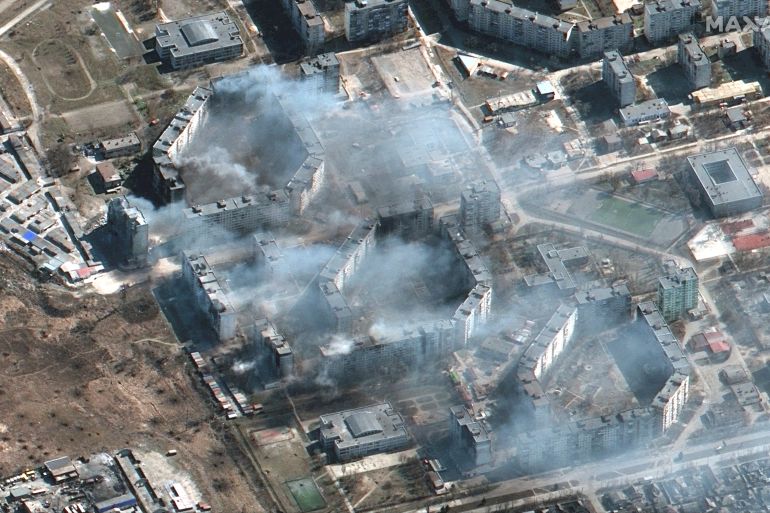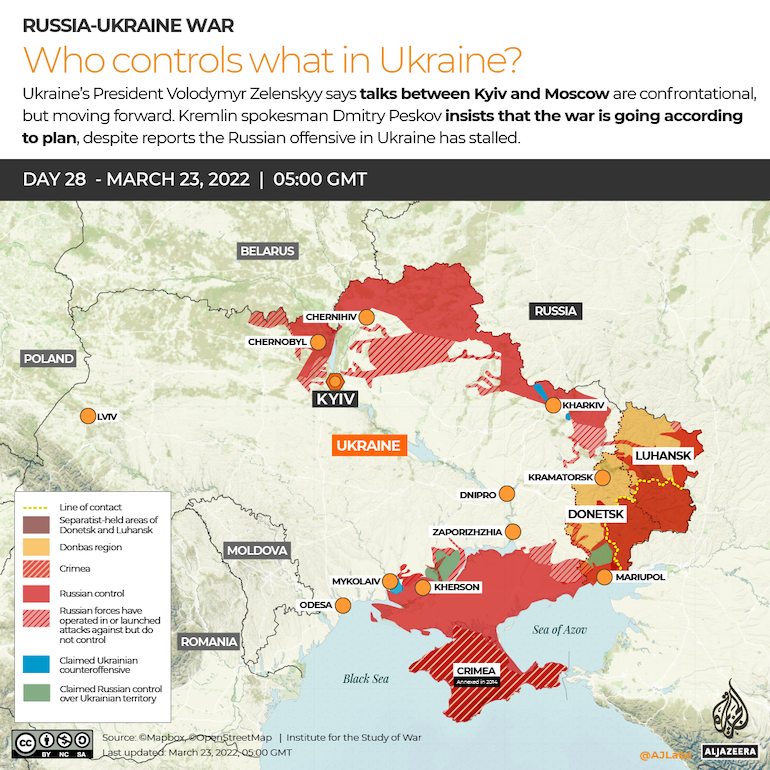Analysis: Russia falls back on urban siege warfare in Ukraine
Sequential urban sieges are brutally effective, but ensure lasting hatred from the population and make long-term political success unlikely.

One month after Russia launched a full-scale invasion of Ukraine, the Russian army has failed to execute a swift takeover of its neighbour and install a pro-Kremlin puppet government in the capital, Kyiv.
The Russian plan to surround key cities with rapidly inserted airborne forces and ground troops driving along major roads relied on the assumption that Ukrainian resistance would be chaotic and light.
Keep reading
list of 4 itemsRussia-Ukraine war: List of key events, day 792
Risk of military incidents on Belarus-Ukraine border quite high: Lukashenko
Ukrainians sigh with relief as US unlocks aid but say it won’t repel Russia
Instead, resistance has been fierce from both the regular Ukrainian army and volunteer and reserve forces across most of the country. Meanwhile, attempts to assassinate or kidnap President Volodomyr Zelenskyy and other key leaders at the national and local government levels were foiled by rapid Ukrainian action and poor Russian operational security measures.
Throughout the first month of the campaign, Russian troop morale has also been generally low, and tactical coordination between forces very poor.

As a result of these failures, Russian forces have achieved very limited territorial gains in the north around Kyiv, northeast around Kharkiv and Sumy, and in the southwest around Mykolaiv.
They have had more success in the east in the Donbas and the southeast around Melitopol and Mariupol – but have still failed to take the latter by force despite weeks of continuous bombardment and attacks.
In return for these limited gains, Russia has lost a huge amount of equipment – visually confirmed losses reportedly amount to more than 1,700 vehicles, including more than 270 main battle tanks, 15 fixed-wing aircraft and 35 helicopters; and the true total is undoubtedly higher. The personnel casualties are difficult to estimate with any precision but the first public assessment by NATO officials suggests between 7,000 and 15,000 killed in action, with total casualties including those captured, wounded or missing at between 30,000 and 40,000.
Regardless of the precise figures – which are unknowable for all sides at this stage – US officials estimate the Russian army has lost more than 10 percent of the 190,000-strong force it had amassed around Ukraine in the eight months leading up to the February 24 invasion.
Perhaps most significantly of all, however, is the fact that the Russian army’s logistics system has proven completely inadequate to supply the five main axes of advance around Kyiv, Kharkiv, Donbas, Mariupol and Mykolaiv/Kryvyi Rih with sufficient food, fuel, ammunition and medical supplies.
As a result, Russian troops have been systemically abandoning their vehicles and equipment – more than 800 of their confirmed vehicle losses had been either abandoned and subsequently destroyed, or abandoned and then captured by Ukrainian troops. The latest intelligence updates from the US suggest that frostbite is taking a toll on troops around Mykolaiv and in the northern areas near Kyiv and Kharkiv due to a lack of suitable cold-weather clothing. Perhaps most importantly of all, the Russian army has lost at least 550 supply trucks in continual Ukrainian attacks on its supply lines.
The consequence of these setbacks is that the Russian strategy has shifted from the attempt to take Kyiv and subdue the whole of the country to one of sequential urban sieges.
Since its logistics system and general fighting capability are insufficient to maintain any serious momentum in most of Ukraine, Russian forces are now concentrating specifically on Mariupol.
Weeks of bombardment of the key port city, as well as Kharkiv, Sumy and Chernihiv, have failed to induce Ukrainian forces to surrender, and Russian troops have taken heavy losses attempting to fight their way into the cities themselves. The plan appears to be to concentrate most of the available logistics capacity and mobile forces to increase the intensity of the bombardment against Mariupol still further, starve the city into submission and then take possession of the ruins with overwhelming force.
Mariupol was surrounded too early in the war for the Ukrainian government to build up supplies of dry food, medicine and ammunition to withstand a long siege. As such, it is testimony to the extraordinary bravery and resilience of the defending forces that they are still holding Russian forces at bay in the centre of the city a month later.
However, Russia is betting that by concentrating on this effort, it can win its first major victory of the invasion and then redirect forces and logistics capacity elsewhere – most likely towards the Donbas and ultimately Kharkiv in the east and northeast.
Russian experience in the 1990s in Grozny, Chechnya, and Homs and Aleppo in the mid-2010s in Syria, suggests that sequential urban sieges are a brutal but effective way to take cities. However, they also ensure the lasting hatred of the population and make long-term political success unlikely in conquered areas unless the population is completely driven out or killed.
This new Russian strategy presents Ukraine with a challenge. Ukrainian forces lack the heavily equipped and armoured forces to conduct major counteroffensives against well-fortified Russian positions. Ukraine has been careful to minimise the visibility of its own casualties and losses, but they have undoubtedly lost several thousand troops killed and wounded, along with at least 500 confirmed vehicles. Despite their losses and the disparity in heavy firepower, the Ukrainians must keep up the pressure on Russia’s forward positions in the areas of the country where the latter have run out of momentum.
If they can bypass the stalled Russian front-line units and cut off their supply routes with light infantry equipped with numerous anti-tank missiles, they will either force those units to withdraw back towards their starting positions or force Russia to pull forces away from its attempt to concentrate on Mariupol and the Donbas to reinforce its threatened positions elsewhere.
Successful local counteroffensives at Mykolaiv in the southwest and Makariv in the northwest in the past week suggest that this is exactly what Ukraine is now trying to do.
Justin Bronk is a senior research fellow in military sciences at the Royal United Services Institute in London
The views expressed in this article are the author’s own and do not necessarily reflect Al Jazeera’s editorial policy